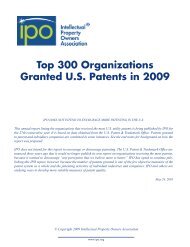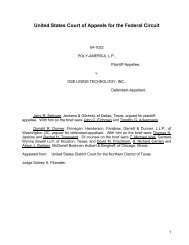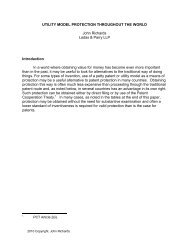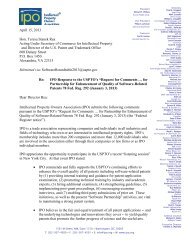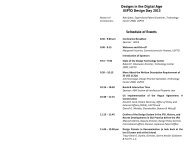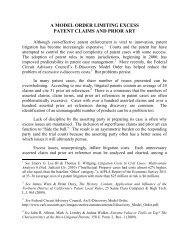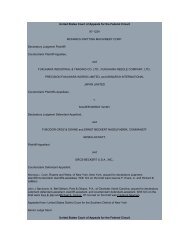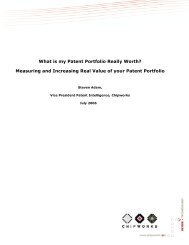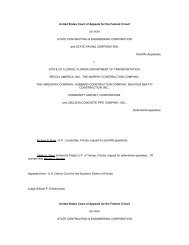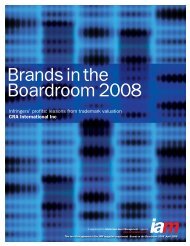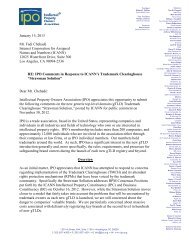KSR International Co. v. Teleflex Inc. â Obviousness Revisited
KSR International Co. v. Teleflex Inc. â Obviousness Revisited
KSR International Co. v. Teleflex Inc. â Obviousness Revisited
You also want an ePaper? Increase the reach of your titles
YUMPU automatically turns print PDFs into web optimized ePapers that Google loves.
INTELLECTUAL PROPERTY AND TECHNOLOGY LAW<br />
Jon R. Trembath, Denver, of Merchant & Gould, practices general Intellectual Property law with an emphasis on patent<br />
litigation. He has litigation experience involving patents, trademarks, copyrights, and trade secrets. Jon has participated in several<br />
successful appeals to the <strong>Co</strong>urt of Appeals for the Federal Circuit. Jon also counsels clients on Intellectual Property protection. He<br />
has worked in the following technology areas: software, integrated circuit fabrications and design, radios, medical/dental devices, oil<br />
field exploration and production, underground boring, pipe lining, chemical manufacturing, waste remediation, and consumer<br />
goods—(303) 357-1670.<br />
This article provides an overview of “obviousness” in terms of patent law. The discussion focuses on the<br />
U.S. Supreme <strong>Co</strong>urt’s opinion in <strong>KSR</strong> <strong>International</strong> <strong>Co</strong>. v. <strong>Teleflex</strong> <strong>Inc</strong>. and federal appellate cases<br />
applying the analysis set forth in that opinion.<br />
<strong>KSR</strong> <strong>International</strong> <strong>Co</strong>. v.<br />
<strong>Teleflex</strong> <strong>Inc</strong>.—<strong>Obviousness</strong><br />
<strong>Revisited</strong><br />
by Jon R. Trembath<br />
The field of patent law experienced many significant changes in 2007.<br />
This article focuses on one case in particular. The opinion in <strong>KSR</strong><br />
<strong>International</strong> <strong>Co</strong>. v. <strong>Teleflex</strong> <strong>Inc</strong>. 1 likely will have the greatest impact of the<br />
cases decided in 2007. <strong>KSR</strong> revised the standards by which courts assess<br />
the requirement that, for an invention to be patentable, it must not be<br />
“obvious.” In particular, <strong>KSR</strong> addresses how courts will consider “prior<br />
art”—that is, a combination of ideas in the public domain—to determine<br />
whether an invention is obvious and therefore not patentable.<br />
1. <strong>KSR</strong> Int’l <strong>Co</strong>. v. <strong>Teleflex</strong> <strong>Inc</strong>., 127 S.Ct. 1727 (2007).
In <strong>KSR</strong>, the U.S. Supreme <strong>Co</strong>urt rejected a restrictive test developed by<br />
the U.S. <strong>Co</strong>urt of Appeals for the Federal Circuit, which required a showing<br />
of a “teaching, suggestion or motive” to combine prior art references to<br />
invalidate a patent claim for being obvious. In its place, the <strong>Co</strong>urt adopted a<br />
more flexible test that focuses on whether the prior art “predicted” the<br />
combination, while acknowledging that a motive to combine prior art<br />
teachings may inform the analysis. Although <strong>KSR</strong> makes it easier to prove<br />
“obviousness,” its full impact will only be determined as lower courts apply<br />
its teachings in future cases.<br />
Background: Patents and <strong>Obviousness</strong><br />
The U.S. patent system is intended to promote innovation. A patent<br />
gives an inventor a limited time during which others may be precluded<br />
from practicing an invention. However, innovation may be stifled if<br />
advances adding insignificantly to society’s collective knowledge are<br />
rewarded with patents, precluding others from use of the insignificant<br />
advances. Thus, there is an inherent tension between protecting worthy<br />
innovation and keeping commonly understood concepts available as<br />
building blocks for future innovation.<br />
Section 103 of Title 35 of the U.S. <strong>Co</strong>de is intended to help the U.S.<br />
Patent Office and the courts strike the correct balance when considering<br />
whether an innovation is worthy of patent protection. <strong>Co</strong>ngress determined<br />
that inventions that are “obvious” to those familiar with the relevant<br />
technological landscape lack the minimal amount of creativity required for<br />
a patent. Section 103 precludes patentability when<br />
the differences between the subject matter sought to be patented and the<br />
prior art are such that the subject matter as a whole would have been<br />
obvious at the time the invention was made to a person having ordinary<br />
skill in the art to which said subject matter pertains. 2<br />
2. 35 U.S.C. § 103.
Patent law thus requires some minimal level of creativity for an invention<br />
to be patentable.<br />
What is “obvious” under 35 U.S.C. § 103 apparently is not that obvious,<br />
because several Supreme <strong>Co</strong>urt opinions have addressed how obviousness<br />
should be determined. Lower courts have struggled with articulating viable<br />
standards for assessing obviousness. <strong>KSR</strong>, the Supreme <strong>Co</strong>urt’s latest<br />
consideration of obviousness, rejected a standard adopted by the U.S. <strong>Co</strong>urt<br />
of Appeals for the Federal Circuit, and offers some guidance for analyzing<br />
obviousness. Understanding prior Supreme <strong>Co</strong>urt opinions puts <strong>KSR</strong> in<br />
context and helps assess its impact on the obviousness analysis.<br />
History: U.S. Supreme <strong>Co</strong>urt Case Law<br />
The generally applied roadmap for assessing obviousness under § 103<br />
was set forth in Graham v. John Deere <strong>Co</strong>. 3 It provides:<br />
Under § 103, the scope and content of the prior art are to be determined;<br />
differences between the prior art and the claims at issue are to be<br />
ascertained; and the level of ordinary skill in the pertinent art resolved.<br />
Against this background the obviousness or non-obviousness of the<br />
subject matter is determined. Such secondary considerations as<br />
commercial success, long felt but unsolved needs, failure of others, etc.,<br />
might be utilized to give light to the circumstances surrounding the<br />
origin of the subject matter sought to be patented. 4<br />
Graham has been the touchstone for the obviousness analysis since its<br />
issuance in 1966.<br />
The Anderson’s-Black Rock and Sakraida Opinions<br />
3. Graham v. John Deere <strong>Co</strong>., 383 U.S. 1 (1966).<br />
4. Id. at 17-18.
Two other cases that address obviousness are Anderson’s-Black Rock,<br />
<strong>Inc</strong>. v. Pavement Salvage <strong>Co</strong>. 5 and Sakraida v. AG Pro, <strong>Inc</strong>. 6 However,<br />
unlike Graham, these cases had been ignored, effectively vacated sub<br />
silencio, by the Federal Circuit. Because <strong>KSR</strong> arguably revives Anderson’s-<br />
Black Rock and Sakraida, knowledge of these opinions is helpful to<br />
understanding <strong>KSR</strong>.<br />
In Anderson’s-Black Rock, the invention was placement of a radiantheat<br />
burner on a standard asphalt paving machine. 7 Use of radiant heat with<br />
asphalt was known. 8 Placing the heater on the paving machine improved<br />
the bonding of subsequent layers of asphalt and thus improved the overall<br />
quality of the pavement placement. 9 However:<br />
The combination of putting the burner together with the other elements<br />
in one machine, though perhaps a matter of great convenience, did not<br />
produce a “new or different function,” within the test of validity of<br />
combination patents. 10<br />
According to the <strong>Co</strong>urt, an obviousness analysis could be informed by<br />
whether synergy existed in the combination of known elements. The <strong>Co</strong>urt<br />
stated, “A combination of elements may result in an effect greater than the<br />
sum of the several effects taken separately. No such synergistic result is<br />
argued here.” 11<br />
The <strong>Co</strong>urt concluded:<br />
while the combination of old elements performed a useful function, it<br />
added nothing to the nature and quality of the radiant-heat burner<br />
5. Anderson’s-Black Rock, <strong>Inc</strong>. v. Pavement Salvage <strong>Co</strong>., 396 U.S. 57 (1969).<br />
6. Sakraida v. AG Pro, <strong>Inc</strong>., 425 U.S. 273 (1976).<br />
7. Anderson’s-Black Rock, supra note 6 at 59.<br />
8. Id. at 60.<br />
9. Id. at 58-60.<br />
10. Id. at 60 (citation omitted).<br />
11. Id. at 61 (emphasis added).
already patented. We conclude further that[,] to those skilled in the art[,]<br />
the use of the old elements in combination was not an invention by the<br />
obvious-nonobvious standard. Use of the radiant-heat burner in this<br />
important field marked a successful venture. But as noted, more than<br />
that is needed for invention. 12<br />
Sakraida was the last significant word on obviousness from the<br />
Supreme <strong>Co</strong>urt before <strong>KSR</strong>. The invention in Sakraida was the rapid<br />
release of a sheet of water to clean a barn floor. 13 The Sakraida <strong>Co</strong>urt<br />
quoted the following from Great A. & P. Tea <strong>Co</strong>. v. Supermarket <strong>Co</strong>rp.: 14<br />
<strong>Co</strong>urts should scrutinize combination patent claims with a care<br />
proportioned to the difficulty and improbability of finding invention in<br />
an assembly of old elements. . . . A patent for a combination which only<br />
unites old elements with no change in their respective functions . . .<br />
obviously withdraws what already is known into the field of its<br />
monopoly and diminishes the resources available to skillful men. . . . 15<br />
In responding to the <strong>Co</strong>urt of Appeals’ conclusion that the invention<br />
achieved a “synergistic result through a novel combination,” the Sakraida<br />
<strong>Co</strong>urt stated:<br />
We cannot agree that the combination of these old elements to produce<br />
an abrupt release of water directly on the barn floor from storage tanks<br />
or pools can properly be characterized as synergistic, that is, “result[ing]<br />
in an effect greater than the sum of the several effects taken separately.”<br />
Rather, this patent simply arranges old elements with each performing<br />
the same function it had been known to perform. . . . Such combinations<br />
are not patentable under standards appropriate for a combination patent.<br />
. . . [T]his assembly of old elements that delivers water directly rather<br />
12. Id. at 62-63.<br />
13. Sakraida, supra note 7 at 277.<br />
14. Great A. & P. Tea <strong>Co</strong>. v. Supermarket <strong>Co</strong>rp., 340 U.S. 147, 152 (1950).<br />
15. Sakraida, supra note 7 at 281.
than through pipes or hoses to the barn floor falls under the head of “the<br />
work of the skillful mechanic, not that of the inventor.” Exploitation of<br />
the principle of gravity adds nothing to the sum of useful knowledge<br />
where there is no change in the respective functions of the elements of<br />
the combination; this particular use of the assembly of old elements<br />
would be obvious to any person skilled in the art of mechanical<br />
application. 16<br />
The Anderson’s-Black Rock and Sakraida opinions, read together, suggest<br />
that the Supreme <strong>Co</strong>urt believed an invention combining known prior art<br />
elements likely would be obvious, unless some synergy could be shown<br />
from the combination.<br />
History: Federal Circuit Case Law<br />
Formed in 1982, 17 the U.S. <strong>Co</strong>urt of Appeals for the Federal Circuit<br />
generally has exclusive jurisdiction over appeals from patent cases filed in<br />
any U.S. District <strong>Co</strong>urt. In the years preceding the formation of the Federal<br />
Circuit, the United States was struggling with high inflation, declining<br />
innovation, and stagnant growth. 18<br />
One perceived key to economic recovery and stability was the<br />
encouragement of industrial innovation. 19 Studies suggested industrial<br />
innovation was being impeded by the lack of uniformity in the application<br />
of patent laws. 20 The Federal Circuit was formed to “bring consistency into<br />
16. Id. at 282 (citations omitted, emphasis added).<br />
17. Pub. L. No. 97-164, 96 Stat. 25 (1982).<br />
18. Bennett, ed., The U.S. <strong>Co</strong>urt of Appeals for the Federal Circuit—A History 1982-1990 at 8<br />
(The United States Judicial <strong>Co</strong>nference <strong>Co</strong>mmittee on the Bicentennial of the <strong>Co</strong>nstitution of the<br />
United States, 1991).<br />
19. Id.<br />
20. Id. at 8-9.
this field of law and to restore the incentive for technological innovation.” 21<br />
<strong>Co</strong>ngress anticipated the resulting uniformity would “foster technological<br />
growth.” 22<br />
The Federal Circuit quickly distanced itself from Anderson’s-Black<br />
Rock and Sakraida. In ASC Hospital Systems v. Montefiore Hospital, 23 the<br />
Federal Circuit held that “teachings of [prior art] references can be<br />
combined only if there is some suggestion or incentive to do so” (emphasis<br />
in original). This was a fundamental shift in favor of the patentee from<br />
Anderson’s-Black Rock and Sakraida.<br />
The Federal Circuit’s position evolved into a requirement that<br />
obviousness could be found only if some “teaching, suggestion or<br />
motivation” to combine the prior art references could be shown in the prior<br />
art. 24 The Federal Circuit ignored the Supreme <strong>Co</strong>urt’s use of synergy to<br />
evaluate the obviousness of a combination of known elements.<br />
The Federal Circuit cited Anderson’s-Black Rock only twice before the<br />
Supreme <strong>Co</strong>urt granted certiorari in <strong>KSR</strong> 25 —once calling a district court’s<br />
citation to Anderson’s-Black Rock a lapse; and once simply ignoring the<br />
obviousness analysis. 26 Before <strong>KSR</strong>, Sakraida was cited four times by the<br />
Federal Circuit. In each instance, Sakraida was not followed. 27<br />
21. Id. at 11.<br />
22. H.R. Rep. No. 97-312, at 20 (1981).<br />
23. ASC Hospital Systems v. Montefiore Hospital, 732 F.2d 1572, 1577 (Fed.Cir. 1984).<br />
24. See, e.g., Al-Site <strong>Co</strong>rp. v. VSI Int’l, <strong>Inc</strong>., 174 F.3d 1308, 1323-24 (Fed.Cir. 1999).<br />
25. Dystar Textilfarben GmbH v. C.H. Patrick <strong>Co</strong>., 464 F.3d 1356, 1369 (Fed.Cir. 2006),<br />
references Anderson’s-Black Rock and Sakraida and was decided after certiorari had been granted<br />
in <strong>KSR</strong>.<br />
26. See Fromson v. Advance Offset Plate, 755 F.2d 1549, 1557 (Fed.Cir. 1985) (discussing<br />
Anderson’s-Black Rock but disregarding the synergy analysis); Gardner v. TEC Sys., <strong>Inc</strong>., 725 F.2d<br />
1338, 1343 (Fed.Cir. 1984), en banc (“the trial court unfortunately and unnecessarily lapsed into<br />
enunciating what it apparently perceived to be an additional requirement for patentability. . . .” The
It generally was recognized that Anderson’s-Black Rock and Sakraida<br />
had been tacitly overruled. As noted in a law school case book, “[i]n its<br />
early decisions, the Federal Circuit essentially repudiated the holdings of<br />
Anderson’s-Black Rock and Sakraida.” 28 It was common knowledge that<br />
“[t]he impact of Anderson’s-Black Rock and Sakraida, has not been<br />
significant. The court of Appeals for the Federal Circuit, which exercises<br />
exclusive jurisdiction over patent appeals, essentially has ignored these<br />
decisions. . . .” 29<br />
The <strong>KSR</strong> Case<br />
The patent claim at issue in <strong>KSR</strong> related to where a wireless sensor<br />
could be placed on an automotive gas pedal. 30 The Asano patent was a prior<br />
art reference “teaching”—that is, explaining or demonstrating—a pedal that<br />
could be adjusted relative to a driver and that had a fixed pivot point. 31<br />
lapse was requiring the “synergistic result” found in Anderson’s-Black Rock in an obviousness<br />
analysis.)<br />
27. See Ashland Oil, <strong>Inc</strong>. v. Delta Resins & Refratories, <strong>Inc</strong>., 776 F.2d 281, 306 n.43 (Fed.Cir.<br />
1985) (mentioning Sakraida but ignoring the “synergy” analysis); Interconnect Planning <strong>Co</strong>rp. v.<br />
Feil, 774 F.2d 1132, 1143 (Fed.Cir. 1985) ( mentioning Sakraida but ignoring the “synergy”<br />
analysis); Merck & <strong>Co</strong>. v. Biocraft Labs., 874 F.2d 804, 808 (Fed.Cir. 1989) (“[s]ynergism is not a<br />
requirement of nonobviousness”); Medtronic, <strong>Inc</strong>. v. Cardiac Pacemakers, <strong>Inc</strong>., 721 F.2d 1563,<br />
1566 (Fed.Cir. 1983) (“[w]e cannot construe [‘courts should scrutinize combination patent claims<br />
with a care proportioned to the difficulty and improbability of finding inventions in an assembly of<br />
old elements’], take from [Sakradia] as a rule of law applicable broadly to patent cases. . . .”).<br />
28. Adelman et al., Cases and Materials on Patent Law (2d ed. 2003).<br />
29. Oddi, “Beyond <strong>Obviousness</strong>: Invention Protection in the Twenty-First Century,” 38<br />
Am. U. L.Rev. 1097, 1123 (1989).<br />
30. <strong>KSR</strong>, supra note 2 at 1735.<br />
31. Id. at 1735.
Defendant <strong>KSR</strong> argued that Asano, combined with prior electronic sensor<br />
art, rendered the patent invalid. 32<br />
District <strong>Co</strong>urt Ruling<br />
The district court granted summary judgment of invalidity, finding the<br />
claimed invention obvious. 33 The district court found “little difference”<br />
between the prior art and the claimed invention. 34 Applying the analysis<br />
mandated by Graham, the court determined that Asano taught everything<br />
claimed “except the use of a sensor to detect the pedal’s position and<br />
transmit it to the computer controlling the throttle.” 35 The district court<br />
observed the missing idea was disclosed in the prior art. 36<br />
Reversal by the Federal Circuit<br />
The Federal Circuit reversed, relying primarily on the failure to satisfy<br />
the so-called “teaching, suggestion or motivation” (TSM) test. 37<br />
Specifically, the Federal Circuit faulted the district court for failing to make<br />
“findings as to the specific understanding or principle within the knowledge<br />
of a skilled artisan that would have motivated one with no knowledge of<br />
[the] invention . . . to attach an electronic control to the support bracket of<br />
the Asano assembly.” 38 The court concluded there was no motivation for an<br />
inventor to look at the prior art relied on by the district court. 39 Also, the<br />
32. Id. at 1738.<br />
33. Id. at 1737-38.<br />
34. Id. at 1738.<br />
35. Id.<br />
36. Id. at 1736, 1738.<br />
37. Id. at 1738.<br />
38. Id.<br />
39. Id.
court found a genuine issue of material fact requiring a trial, because expert<br />
testimony that the claimed invention was not obvious was presented. 40<br />
The Supreme <strong>Co</strong>urt Opinion<br />
The Supreme <strong>Co</strong>urt began its analysis by tersely stating: “We begin by<br />
rejecting the rigid approach of the <strong>Co</strong>urt of Appeals.” 41 The <strong>Co</strong>urt then<br />
discussed its prior cases focusing on predictability, beginning with Great A.<br />
& P. Tea <strong>Co</strong>. v. Supermarket Equipment <strong>Co</strong>rp. 42 The <strong>Co</strong>urt offered the<br />
following from Great Atlantic as the “principal reason for declining to<br />
allow patents for what is obvious”—a “patent for a combination which only<br />
unites old elements with no change in their respective functions . . .<br />
obviously withdraws what is already known into the field of its monopoly<br />
and diminishes the resources available to skillful men.” 43 The <strong>Co</strong>urt<br />
concluded: “The combination of familiar elements according to known<br />
methods is likely to be obvious when it does no more than yield predictable<br />
results.” 44<br />
Citing United States v. Adams 45 as an example of what was not<br />
obvious, 46 the <strong>Co</strong>urt observed that Adams “recognized that when a patent<br />
claims a structure already known in the prior art that is altered by the mere<br />
substitution of one element for another known in the field, the combination<br />
must do more than yield a predictable result.” 47 The invention in Adams<br />
40. Id. at 1739.<br />
41. Id.<br />
42. Id. Great A. & P. Tea <strong>Co</strong>. was decided before the 1952 Patent Act that created 35 U.S.C. §<br />
103.<br />
43. Id. at 1739, quoting Great A. & P. Tea <strong>Co</strong>., supra note 15 at 152.<br />
44. Id. (emphasis added).<br />
45. United States v. Adams, 383 U.S. 39 (1966).<br />
46. <strong>KSR</strong>, supra note 2 at 1739-40.<br />
47. Id. at 1740 (emphasis added).
was deemed not obvious because “the elements worked together in an<br />
unexpected and fruitful manner.” 48<br />
The invention in Anderson’s-Black Rock was a device that “did not<br />
create some new synergy.” 49 The elements functioned just as they were<br />
expected to function and “in combination did no more than they would in<br />
separate, sequential operation.” 50 According to Sakraida, a patent that<br />
“‘simply arranges old elements with each performing the same function it<br />
had been known to perform’ and yields no more than one would expect<br />
from such an arrangement, the combination is obvious.” 51<br />
In summary, the <strong>Co</strong>urt stated:<br />
When a work is available in one field of endeavor, design incentives and<br />
other market forces can prompt variations of it, either in the same field<br />
or a different one. If a person of ordinary skill can implement a<br />
predictable variation, § 103 likely bars its patentability. . . . [A] court<br />
must ask whether the improvement is more than the predictable use of<br />
prior art element according to their established functions. 52<br />
The Supreme <strong>Co</strong>urt’s Analysis<br />
After resurrecting Anderson’s-Black Rock and Sakraida from the grave<br />
of disregarded precedent and rejecting the “rigid” TSM approach applied<br />
by the Federal Circuit, the <strong>Co</strong>urt set forth a more flexible approach to<br />
assessing obviousness. To understand the <strong>Co</strong>urt’s approach, it is helpful to<br />
consider the <strong>Co</strong>urt’s understanding of why obviousness is part of Title 35:<br />
We build and create by bringing to the tangible and palpable reality<br />
around us new works based on instinct, simple logic, ordinary<br />
48. Id.<br />
49. Id.<br />
50. Id.<br />
51. Id., quoting Sakraida, supra note 7 at 282.<br />
52. Id. (emphasis added).
inferences, extraordinary ideas, and sometimes even genius. These<br />
advances, once part of our shared knowledge, define a new threshold<br />
from which innovation starts once more. And as progress beginning<br />
from higher levels of achievement is expected in the normal course, the<br />
results of ordinary innovation are not the subject of exclusive rights<br />
under the patent laws. Were it otherwise patents might stifle, rather than<br />
promote, the progress of useful arts. These premises led to the bar on<br />
patents claiming obvious subject matter established in Hotchkiss and<br />
codified in § 103. Application of the bar must not be confined within a<br />
test or formulation too constrained to serve its purpose. 53<br />
The <strong>Co</strong>urt’s flexible analysis is intended to protect only ideas beyond<br />
the ordinary while leaving the rest open for exploitation. The <strong>Co</strong>urt did not<br />
create a rule that inventions derived from combining known elements are<br />
per se obvious. The fact that every element of an invention existed in prior<br />
art does not mean that the invention is necessarily obvious: 54<br />
This is so because inventions in most, if not all, instances rely upon<br />
building blocks long since uncovered, and claimed discoveries almost of<br />
necessity will be combinations of what, in some sense, is already<br />
known. 55<br />
In many instances, there may be prior art references that might in some<br />
way, at some level of abstraction, disclose the elements of an invention.<br />
Thus the question is how to determine whether a combination is not<br />
obvious and thus protectable or obvious and in the public domain.<br />
The <strong>Co</strong>urt used Adams as an example of a nonobvious invention made<br />
by combining elements known in the prior art. 56 There, the prior art taught<br />
53. Id. at 1746 (citation omitted).<br />
54. Id. at 1741.<br />
55. Id.<br />
56. Id.
away from the solution identified in the patent at issue. 57 In finding the<br />
invention not obvious, the Adams <strong>Co</strong>urt relied on the “principle that when<br />
the prior art teaches away from combining certain known elements,<br />
discovery of a successful means of combining them is more likely to be<br />
nonobvious.” 58<br />
Although it strongly criticized the rigid application of the TSM test, the<br />
<strong>Co</strong>urt concluded, “There is no necessary inconsistency between the idea<br />
underlying the TSM test and the Graham analysis. But when a court<br />
transforms the general principle into a rigid rule that limits the obviousness<br />
inquiry, as the <strong>Co</strong>urt of Appeals did here, it errs.” 59 The <strong>Co</strong>urt<br />
characterized the TSM test as “a helpful insight” and noted “it can be<br />
important to identify a reason that would have prompted a person of<br />
ordinary skill in the relevant field to combine the elements in the way the<br />
claimed new invention does.” 60<br />
The <strong>Co</strong>urt’s discussion of Adams and the TSM test suggest that a proper<br />
analysis will consider what was known about the elements of a claimed<br />
invention before the inventor filed for the patent. Evidence suggesting the<br />
combination embodied in the claimed invention would not work, or that the<br />
combination should not be tried, weighs in favor of nonobviousness. On the<br />
other hand, evidence suggesting the combination weighs in favor of<br />
obviousness.<br />
The <strong>Co</strong>urt provided guidance about what evidence might suggest a<br />
combination, while rejecting an “overemphasis on the importance of<br />
published articles and the explicit content of issued patents.” 61 These<br />
provide a beginning point in the search for a motive to combine the claimed<br />
57. Id.<br />
58. Id.<br />
59. Id.<br />
60. Id.<br />
61. Id.
elements. Stressing the fundamental tenets of its earlier (and largely<br />
ignored) opinions on the matter, the <strong>Co</strong>urt emphasized that the obviousness<br />
inquiry required a flexible, “common-sense” approach that invites<br />
questions, such as whether the invention addresses a known problem or<br />
market pressure by implementing an idea from a finite set of solutions<br />
familiar to those of ordinary skill in the field. 62<br />
Specifically, the <strong>Co</strong>urt stated:<br />
When there is a design need or market pressure to solve a problem and<br />
there are a finite number of identified predictable solutions, a person of<br />
ordinary skill has good reason to pursue the known options within his or<br />
her technical grasp. If this leads to the anticipated success, it is likely the<br />
product not of innovation but of ordinary skill and common sense. 63<br />
The <strong>Co</strong>urt rejected the argument that, when evaluating obviousness, the<br />
fact finder is limited to art addressing the specific problem the patentee was<br />
trying to solve. 64 Thus, the inquiry is not whether the invention was<br />
obvious to the actual patentee; as long as someone of ordinary skill would<br />
look to solve a known problem in the manner selected by the patentee, the<br />
invention may have been obvious and therefore unpatentable.<br />
As a further example, in rejecting the TSM test, the <strong>Co</strong>urt stated, “Rigid<br />
preventative rules that deny fact finders recourse to common sense,<br />
however, are neither necessary under our case law nor consistent with it.” 65<br />
In somewhat of a restatement, the <strong>Co</strong>urt explained, “A person of ordinary<br />
skill is also a person of ordinary creativity, not an automaton.” 66 When<br />
considered in light of the function obviousness plays in balancing reward<br />
for patentable invention against the desire to leave the building blocks for<br />
62. Id. at 1742.<br />
63. Id. at 1741.<br />
64. Id. at 1742.<br />
65. Id. at 1742-43.<br />
66. Id. at 1742.
ordinary innovation in the public domain, the focus on common sense<br />
weaves the teachings of <strong>KSR</strong> into a useful addition to the fabric of<br />
obviousness law.<br />
Application of the Analysis<br />
<strong>Obviousness</strong> is not easily defined and must be evaluated on a case-bycase<br />
basis. The overall objective of promoting innovation must inform each<br />
analysis as a court asks “whether the improvement is more than the<br />
predictable use of prior art elements according to their established<br />
functions.” 67 As the evaluation is made, a court will consider what a person<br />
of skill in the art with ordinary creativity would have felt about the<br />
innovation: Did the prior art teach away from what was claimed? Did<br />
market pressure or the natural evolution of development in the field lead to<br />
ordinary innovation? Did the prior art itself teach making the claimed<br />
combination? Focusing on common sense, the court then would determine<br />
whether it would have been obvious to combine the prior art elements to<br />
create the claimed invention.<br />
<strong>Obviousness</strong> and Summary Judgment<br />
As noted above, the Federal Circuit offered the existence of a genuine<br />
issue of material fact as an additional reason for reversing the district<br />
court’s grant of summary judgment of invalidity. 68 The Supreme <strong>Co</strong>urt<br />
disagreed, stating:<br />
The ultimate judgment of obviousness is a legal determination. Where,<br />
as here, the content of the prior art, the scope of the patent claim, 69 and<br />
67. Id. at 1740.<br />
68. Id. at 1745.<br />
69. The scope of a patent claim also is a question of law. See Markman v. Westview<br />
Instruments, <strong>Inc</strong>., 517 U.S. 370, 391 (1996). Thus, what the <strong>Co</strong>urt intended by mentioning “scope of<br />
a patent” is open to question.
the level of ordinary skill in the art are not in material dispute, and the<br />
obviousness of the claim is apparent in light of these factors, summary<br />
judgment is appropriate. 70<br />
Post-<strong>KSR</strong> Case Law<br />
Anderson’s-Black Rock and Sakraida suggest an invention lacking<br />
unexpected synergy is obvious. <strong>KSR</strong> arguably resurrected Anderson’s-Black<br />
Rock and Sakraida and the requirement that synergy be shown to avoid<br />
obviousness. On the other hand, <strong>KSR</strong> arguably did little to change the<br />
Federal Circuit’s requirement that a motive to combine known prior art<br />
elements must be shown to prove obviousness and the purported synergy<br />
requirement, in context, does not affect the obviousness analysis.<br />
The <strong>Co</strong>urt’s focus on predictability may provide a meaningful<br />
touchstone for future obviousness evaluations. In the alternative, it may be<br />
perceived as nothing more than a synonym for obviousness that does little<br />
to change the analysis under § 103. A brief review of post-<strong>KSR</strong> cases<br />
suggests that <strong>KSR</strong> likely tilts the balance in favor of “obviousness”<br />
defenses. However, the balance probably has not shifted so far as to require<br />
a showing of synergy to avoid obviousness, as arguably mandated by<br />
Anderson’s-Black Rock and Sakraida.<br />
Federal Circuit Cases<br />
The Federal Circuit has not ignored <strong>KSR</strong>. Most post-<strong>KSR</strong> Federal<br />
Circuit opinions addressing the merits of an obviousness challenge have<br />
resulted in patent claims being obvious. The more important post-<strong>KSR</strong><br />
Federal Circuit opinions are discussed below.<br />
In re Translogic Technology, <strong>Inc</strong>. 71 Here, the Federal Circuit affirmed<br />
a finding of obviousness. The court characterized <strong>KSR</strong> as correcting “a<br />
70. <strong>KSR</strong>, supra note 2 at 1745-46 (citation omitted).<br />
71. In re Translogic Technology, <strong>Inc</strong>., 504 F.3d 1249 (Fed.Cir. 2007).
ather straightforward error”—that the Federal Circuit overlooked the<br />
“proposition that obvious variants of prior art references are themselves<br />
part of the public domain.” 72<br />
After the <strong>KSR</strong> petition for certiorari was filed and before <strong>KSR</strong> issued,<br />
the Federal Circuit suggested its obviousness analysis was “flexible” and<br />
required “consideration of common sense and common knowledge.” 73 The<br />
Federal Circuit also indicated there was no requirement of an actual<br />
teaching to combine references; rather, the motivation to combine could be<br />
found implicitly in the prior art.<br />
The court concluded that Translogic, a patent applicant, was making the<br />
mistake corrected by <strong>KSR</strong> by claiming the prior art cited was not relevant<br />
because it did not address the problem addressed in the patent. 74 The<br />
Translogic court also implied that the Supreme <strong>Co</strong>urt accepted the Federal<br />
Circuit’s post-<strong>KSR</strong> “suggestion” test that “not only permits, but requires,<br />
consideration of common knowledge and common sense.” 75 According to<br />
the court, “an obviousness analysis ‘need not seek out precise teachings<br />
directed to the specific subject matter of the challenged claim, for a court<br />
can take account of the inferences and creative steps that a person of<br />
ordinary skill in the art would employ.’” 76 The court went on to say that a<br />
person of ordinary skill would have “solved the design need by ‘pursu[ing]<br />
known options within his or her technical grasp.” 77 The court concluded<br />
that a person of ordinary skill in the art would have known of the prior art<br />
references and how to combine there teachings. 78<br />
72. Id. at 1257.<br />
73. Id., citing <strong>KSR</strong>, supra note 2 at 1743.<br />
74. Id.<br />
75. Id., quoting <strong>KSR</strong>, supra note 2 at 1743 (emphasis original).<br />
76. Id., quoting <strong>KSR</strong>, supra note 2 at 1741.<br />
77. Id., quoting <strong>KSR</strong>, supra note 2 at 1742).<br />
78. Id.
Aventis Pharma Deutschland GmbH v. Lupin, Ltd. 79 Here, the<br />
patentability of a purified composition was at issue. After noting that <strong>KSR</strong><br />
discouraged application of the TSM test as a rigid, mandatory formula, the<br />
court stated, “It remains necessary to show ‘some articulated reasoning<br />
with some rational underpinning to support the legal conclusion of<br />
obviousness’ but such reasoning ‘need not seek out precise teachings<br />
directed to the specific subject matter of the challenged claim.’” 80<br />
The court found the reasoning supporting obviousness inherent in the<br />
knowledge of a person of ordinary skill in the art, stating, “[o]rdinarily, one<br />
expects a concentrated or purified ingredient to retain the same properties it<br />
exhibited in a mixture, and for those properties to be amplified when the<br />
ingredient is concentrated or purified; isolation of interesting compounds is<br />
a mainstay of the chemist’s art. If it is known how to perform such an<br />
isolation, doing so ‘is likely the product not of innovation but of ordinary<br />
skill and common sense.’” 81 The court also noted there were no unexpected<br />
results and the claims were held obvious. 82<br />
Takeda Chemical Industries, Ltd. v. Alphapharm Pty., Ltd. 83 Here, the<br />
Federal Circuit affirmed a finding that claimed compounds would not have<br />
been obvious. The court noted that <strong>KSR</strong> “acknowledged the importance of<br />
identifying ‘a reason that would have prompted a person of ordinary skill in<br />
the relevant field to combine the elements in the way the claimed new<br />
invention does’ in an obviousness determination.” 84 The court concluded,<br />
“in cases involving new chemical compounds, it remains necessary to<br />
79. Aventis Pharma Deutschland GmbH v. Lupin, Ltd., 499 F.3d. 1293, 1301 (Fed.Cir. 2007).<br />
80. Id. at 1301, quoting In re Kahn, 441 F.3d, 977, 988 (Fed.Cir. 2006) and <strong>KSR</strong>, supra note 2<br />
at 1741.<br />
81. Id. at 1302, quoting <strong>KSR</strong>, supra note 2 at 1742.<br />
82. Id. at 1302-03.<br />
83. Takeda Chemical Industries, Ltd. v. Alphapharm Pty., Ltd., 492 F.3d 1350 (Fed.Cir. 2007).<br />
84. Id. at 1356-57, quoting <strong>KSR</strong>, supra note 2 at 1731.
identify some reason that would have led a chemist to modify a known<br />
compound in a particular manner to establish prima facie obviousness of a<br />
new claimed compound.” 85 The defendant failed to make this required<br />
showing. 86<br />
The accused infringer argued that <strong>KSR</strong> mandated reversal because it<br />
would have been “obvious to try” the claimed compounds. 87 The Federal<br />
Circuit noted that testimony from the defendant’s 30(b)(6) witnesses<br />
suggested there were known negative side effects for compounds similar to<br />
those claimed. 88 The side effects negated the argument that it would have<br />
been “obvious to try” what resulted in the invention. 89<br />
Leapfrog Enterprises v. Fischer-Price, <strong>Inc</strong>. 90 Here, a finding of<br />
obviousness was affirmed. The invention was using modern electronics to<br />
update a mechanical toy that taught reading by associating letters with<br />
sounds. 91 The goal of the claimed invention “was to allow a child to press a<br />
switch associated with a single letter in a word and hear the sound of the<br />
letter as it is used in the word.” 92 A prior art device accomplished the same<br />
end mechanically. 93<br />
The court acknowledged <strong>KSR</strong> taught that “predictable results” is a<br />
marker for obviousness. 94 Although it did not use the word “predictable,”<br />
85. Id. at 1357.<br />
86. Id.<br />
87. Id. at 1359.<br />
88. Id.<br />
89. Id.<br />
90. Leapfrog Enters. v. Fischer-Price, <strong>Inc</strong>., 485 F.3d 1157 (Fed.Cir. 2007).<br />
91. Id. at 1160.<br />
92. Id.<br />
93. Id.<br />
94. Id.
the court focused on the predictability of updating a mechanical device with<br />
modern electronics:<br />
Accommodating a prior art mechanical device that accomplishes that<br />
goal to modern electronics would have been reasonably obvious to one<br />
of ordinary skill in designing children’s learning devices. Applying<br />
modern electronics to older mechanical devices has been commonplace<br />
in recent years. 95<br />
The court found the motivation to upgrade the mechanical system with<br />
modern electronics in the “commonly understood benefits of such<br />
adaptation, such as decreased size, increased reliability, simplified<br />
operation, and reduced cost.” 96 Motivation to combine may be shown when<br />
the reasons for combining prior art are known—such as, adding benefits “to<br />
increase [] marketability.” 97<br />
Addressing the patentee’s burden, the court noted the absence of<br />
evidence that making the combination was “uniquely challenging or<br />
difficult for one of ordinary skill in the art.” 98 “Our conclusion is further<br />
reinforced by testimony from the sole inventor at trial that he did not have a<br />
technical background, could not have actually built the prototype himself,<br />
and relied on the assistance of [others] to build a prototype of his<br />
invention.” 99 This novel analysis suggests the difficulty of reducing an<br />
invention to practice may become a factor when considering obviousness.<br />
Secondary considerations were shown but were found inadequate to<br />
overcome obviousness. 100<br />
95. Id.<br />
96. Id. at 1162.<br />
97. Id.<br />
98. Id.<br />
99. Id.<br />
100. Id.
In re Icon Health and Fitness, <strong>Inc</strong>. 101 Here, the court found a spring<br />
assist for a folding treadmill obvious. The patentee argued that prior art<br />
relating to a folding bed was not relevant art and, therefore, could not<br />
inform an obviousness analysis. 102 The court agreed that the field was<br />
different, but concluded the problem addressed was the same. 103 Relying on<br />
<strong>KSR</strong>, the court stated, “any need or problem known in the field of endeavor<br />
at the time of invention and addressed by the patent can provide a reason<br />
for combining the elements in the manner claimed.” 104<br />
The patentee argued the prior art “taught away” from the claimed<br />
invention. 105 Relying on <strong>KSR</strong>’s statements about predictability, the court<br />
rejected this argument. 106 The prior art taught the exact result claimed,<br />
which apparently was a marker for predictability. 107<br />
The patentee also argued that combining the prior art would yield an<br />
inoperable device. 108 The court first noted that the breadth of the claims<br />
were such that the prior art would create an operable device, satisfying the<br />
claims. 109 The court further reasoned that those of skill in the art would<br />
know how to modify the combination to make it operable. 110<br />
District <strong>Co</strong>urt Cases<br />
101. In re Icon Health and Fitness, <strong>Inc</strong>., 496 F.3d 1374 (Fed.Cir. 2007).<br />
102. Id. at 1379.<br />
103. Id.<br />
104. Id. at 1380, quoting <strong>KSR</strong>, supra note 2 at 1742.<br />
105. Id. at 1381.<br />
106. Id.<br />
107. Id.<br />
108. Id. at 1381-82.<br />
109. Id.<br />
110. Id. at 1382.
Federal district courts have likewise taken note of <strong>KSR</strong>. The relevant<br />
district court decisions are discussed below.<br />
Single Chip Systems <strong>Co</strong>rp. v. Intermec IP <strong>Co</strong>rp. 111 Here, the defendant<br />
proposed a twenty-one-factor test for evaluating obviousness. 112 The U.S.<br />
District <strong>Co</strong>urt for the Southern District of California noted <strong>KSR</strong>’s rejection<br />
of a rigid obviousness analysis and call for common sense, stating, “this<br />
<strong>Co</strong>urt[] rejects that an obviousness analysis requires the rigid application of<br />
a 21-factor test . . . and instead will apply a flexible and expansive approach<br />
as mandated by <strong>KSR</strong>.” 113 Summary judgment of invalidity was granted for<br />
broadly asserted claims, and a genuine issue of material fact was found for<br />
some narrower claims, because there was a question about whether some<br />
references were from analogous art and whether there was a motive to<br />
combine these references. 114<br />
PBI Performance Products, <strong>Inc</strong>. v. Norfab <strong>Co</strong>rp. 115 The U.S. District<br />
<strong>Co</strong>urt for the Eastern District of Pennsylvania rejected the plaintiff’s<br />
attempt to read limitations into the claims from the specification to narrow<br />
the scope of applicable prior art. 116 The motive to combine was found<br />
because the prior art sought to solve the same problem addressed by the<br />
asserted patent. 117 Moreover, the asserted patent merely incorporated “a<br />
predictable use of prior art elements according to their established<br />
111. Single Chip Systems <strong>Co</strong>rp. v. Intermec IP <strong>Co</strong>rp., 495 F.Supp.2d 1066 (S.D.Cal. 2007).<br />
112. Id. at 1078.<br />
113. Id.<br />
114. Id. at 1091.<br />
115. PBI Performance Products, <strong>Inc</strong>. v. Norfab <strong>Co</strong>rp., 514 F.Supp.2d 732 (E.D.Pa. 2007).<br />
116. Id. at 739.<br />
117. Id. at 742.
functions.” 118 Summary judgment of invalidity for obviousness was<br />
granted. 119<br />
Friskit, <strong>Inc</strong>. v. Realnetworks, <strong>Inc</strong>. 120 The U.S. District <strong>Co</strong>urt for the<br />
Northern District of California granted summary judgment of invalidity<br />
based on obviousness. 121 The court determined that the invention was a<br />
combination of known elements that displayed no “new functionality”<br />
when combined—the result of the combination was predictable. 122<br />
Evidence of secondary considerations (objective indicia of nonobviousness)<br />
was shown but was insufficient to overcome the obviousness showing. 123<br />
Depuy Spine, <strong>Inc</strong>. v. Medtronic Sofamor Danek, <strong>Inc</strong>. 124 The<br />
defendants relied on the doctrine of “ensnarement” to preclude application<br />
of the doctrine of equivalents to capture their product. 125 They asserted that<br />
claims broadened under the doctrine of equivalents to cover their product<br />
would necessarily capture prior art, rendering a hypothetical claim with the<br />
broadened scope obvious. 126<br />
The defendants focused on <strong>KSR</strong>’s references to predictability and<br />
suggested that a motivation to combine was no longer relevant to a proper<br />
obviousness analysis. 127 Rejecting this interpretation of <strong>KSR</strong>, 128 the court<br />
118. Id.<br />
119. Id. at 743.<br />
120. Friskit, <strong>Inc</strong>. v. Realnetworks, <strong>Inc</strong>., 499 F.Supp.2d 1145 (N.D.Cal. 2007).<br />
121. Id.<br />
122. Id. at 1153.<br />
123. Id. at 1154.<br />
124. Depuy Spine, <strong>Inc</strong>. v. Medtronic Sofamor Danek, <strong>Inc</strong>., 2007 U.S.Dist.Lexis 90722 (D.Mass.<br />
2007).<br />
125. Id. at 5-8.<br />
126. Id. at 19.<br />
127. Id. at 22.<br />
128. Id. at 22-23.
concluded that <strong>KSR</strong> “reaffirms the relevance of motivation.” 129 The court<br />
analyzed <strong>KSR</strong>, placing the Supreme <strong>Co</strong>urt’s statements in context and<br />
determined that the “bright-lined standard the defendants appear to be<br />
promoting is not consonant with <strong>KSR</strong>’s broader teaching, which suggest<br />
that flexibility and common sense, rather than rigidity and formalism,<br />
should drive the obviousness determination.” 130<br />
Alluding to Anderson’s-Black Rock and Sakraida’s suggestion that<br />
synergy was required to show nonobviousness, defendants also stated<br />
“[u]nder <strong>KSR</strong> a combination of old elements must produce some new or<br />
unexpected result to be patentable.” 131 Based on it analysis of <strong>KSR</strong> and the<br />
mandate for “flexibility and common sense,” the court rejected defendant’s<br />
“synergy” argument. 132<br />
The court found prior art teaching away from the proposed obviousness<br />
combination. 133 Secondary considerations confirmed the lack of<br />
obviousness. 134 The hypothetical claim was found nonobvious and<br />
judgment of $26.3 million was entered. 135<br />
Sud-Chemie, <strong>Inc</strong>. v. Multisorb Technologies, <strong>Inc</strong>. 136 This case appears<br />
to have resurrected the synergy concept from Anderson’s-Black Rock and<br />
Sakraida. Relying on Anderson’s-Black Rock, the U.S. District <strong>Co</strong>urt for<br />
the Western District of Kentucky found that the device did not “create some<br />
new synergy.” 137 The court also appeared to require that elements work<br />
129. Id. at 23.<br />
130. Id. at 24.<br />
131. Id. at 25.<br />
132. Id.<br />
133. Id. at 27, 30.<br />
134. Id. at 37.<br />
135. Id. at 42-43.<br />
136. Sud-Chemie, <strong>Inc</strong>. v. Multisorb Technologies, <strong>Inc</strong>., 2007 Lexis 66507 (W.D.Ky. 2007).<br />
137. Id. at 13, quoting Anderson’s-Black Rock, supra note 6.
“together in an ‘unexpected and fruitful manner’” to avoid obviousness. 138<br />
The claimed invention was found obvious. 139<br />
<strong>Co</strong>nclusion<br />
<strong>KSR</strong> significantly changed the way obviousness is analyzed. The<br />
requirement that a teaching, suggestion, or motivation to combine must be<br />
expressly found in the prior art was rejected. The U.S. Supreme <strong>Co</strong>urt<br />
suggested that predictability may inform an obviousness analysis, and that<br />
common sense is key. The full effect of <strong>KSR</strong> will be ascertained as it is<br />
applied by lower courts. That said, it appears <strong>KSR</strong> shifted the obviousness<br />
analysis in favor of the accused infringer.<br />
Notwithstanding the rejection of the TSM test, an identification of a<br />
motivation to combine references probably still is required, and may be<br />
found in areas not traditionally considered, such as improved marketability.<br />
The predictability of the success of a combination likely will evolve as a<br />
strong factor favoring obviousness. Evidence teaching away from a<br />
combination likely will remain a strong factor favoring nonobviousness.<br />
Synergy likely will not be required to show nonobviousness.<br />
Notes<br />
This article originally appeared in The <strong>Co</strong>lorado Lawyer, Volume 37,<br />
Number 4, April 2008.<br />
138. Id., quoting Adams, supra note 46.<br />
139. Id. at 16.



